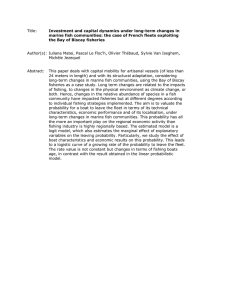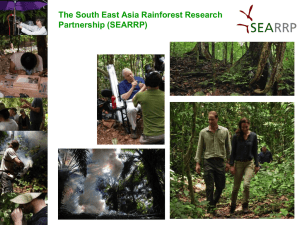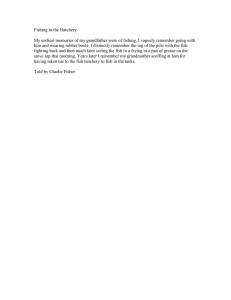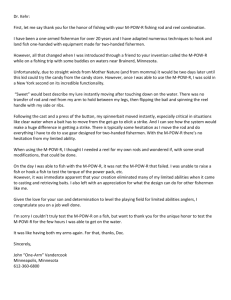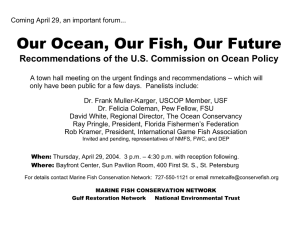SIDP News 3
advertisement
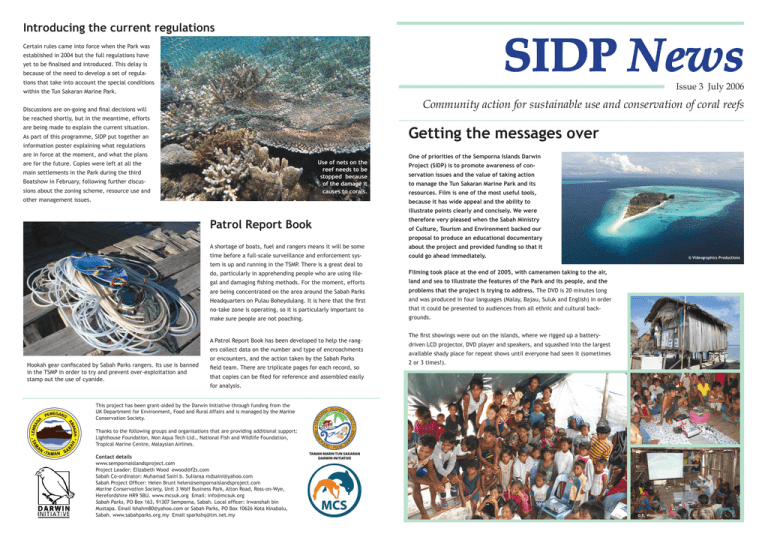
Introducing the current regulations SIDP News Certain rules came into force when the Park was established in 2004 but the full regulations have yet to be finalised and introduced. This delay is because of the need to develop a set of regulations that take into account the special conditions Issue 3 July 2006 within the Tun Sakaran Marine Park. Community action for sustainable use and conservation of coral reefs Discussions are on-going and final decisions will be reached shortly, but in the meantime, efforts Getting the messages over are being made to explain the current situation. As part of this programme, SIDP put together an information poster explaining what regulations are in force at the moment, and what the plans Use of nets on the reef needs to be stopped because of the damage it causes to corals. are for the future. Copies were left at all the main settlements in the Park during the third Boatshow in February, following further discussions about the zoning scheme, resource use and other management issues. One of priorities of the Semporna Islands Darwin Project (SIDP) is to promote awareness of conservation issues and the value of taking action to manage the Tun Sakaran Marine Park and its resources. Film is one of the most useful tools, because it has wide appeal and the ability to illustrate points clearly and concisely. We were Patrol Report Book therefore very pleased when the Sabah Ministry of Culture, Tourism and Environment backed our proposal to produce an educational documentary A shortage of boats, fuel and rangers means it will be some about the project and provided funding so that it time before a full-scale surveillance and enforcement sys- could go ahead immediately. © Videographics Productions tem is up and running in the TSMP. There is a great deal to do, particularly in apprehending people who are using ille- Filming took place at the end of 2005, with cameramen taking to the air, gal and damaging fishing methods. For the moment, efforts land and sea to illustrate the features of the Park and its people, and the are being concentrated on the area around the Sabah Parks problems that the project is trying to address. The DVD is 20 minutes long Headquarters on Pulau Boheydulang. It is here that the first and was produced in four languages (Malay, Bajau, Suluk and English) in order no-take zone is operating, so it is particularly important to that it could be presented to audiences from all ethnic and cultural back- make sure people are not poaching. grounds. A Patrol Report Book has been developed to help the rangers collect data on the number and type of encroachments Hookah gear confiscated by Sabah Parks rangers. Its use is banned in the TSMP in order to try and prevent over-exploitation and stamp out the use of cyanide. or encounters, and the action taken by the Sabah Parks field team. There are triplicate pages for each record, so The first showings were out on the islands, where we rigged up a batterydriven LCD projector, DVD player and speakers, and squashed into the largest available shady place for repeat shows until everyone had seen it (sometimes 2 or 3 times!). that copies can be filed for reference and assembled easily for analysis. This project has been grant-aided by the Darwin Initiative through funding from the UK Department for Environment, Food and Rural Affairs and is managed by the Marine Conservation Society. Thanks to the following groups and organisations that are providing additional support: Lighthouse Foundation, Mon Aqua Tech Ltd., National Fish and Wildlife Foundation, Tropical Marine Centre, Malaysian Airlines. Contact details www.sempornaislandsproject.com Project Leader: Elizabeth Wood ewood@f2s.com Sabah Co-ordinator: Muhamad Saini b. Suliansa mdsaini@yahoo.com Sabah Project Officer: Helen Brunt helen@sempornaislandsproject.com Marine Conservation Society, Unit 3 Wolf Business Park, Alton Road, Ross-on-Wye, Herefordshire HR9 5BU. www.mcsuk.org Email: info@mcsuk.org Sabah Parks, PO Box 163, 91307 Semporna, Sabah. Local officer: Irwanshah bin Mustapa. Email Ishahm80@yahoo.com or Sabah Parks, PO Box 10626 Kota Kinabalu, Sabah. www.sabahparks.org.my Email sparkshq@tm.net.my © E. Wood Surveys and monitoring Through SIDP, steps are being taken to promote sustainable use of natural resources in the Tun Sakaran Marine Park together with conservation of the area’s rich biodiversity. Instant results are not to be expected, but it is vital to set in place a scheme that will provide an indication of success (or otherwise!). We need to know if the management strategies being implemented in the Park are ‘on target’ and will achieve their objectives, or if additional or different management actions are required. Appropriate responses can be made only on the basis of accurate, up-to-date information, which means establishing a monitoring programme to assess the status of the site and see how it is responding both to management initiatives and natural events. Reef fish surveys Community census The TSMP Community Census began in May 2006, and is part of the socio-economic survey and monitoring programme currently underway in the TSMP. The purpose of the census is to record the number of people currently living in the Park and obtain information on social, economic and cultural aspects of the community. The last census was carried out in 1999, but various changes have occurred since then, which is why it is vital to conduct a new survey. Our aim is to cover all the Feedback from the questionnaires is providing information on the households living in the Park, so that we have an accu- comparative importance of activities such as fishing, seaweed rate ‘snapshot’ of the current population. The specially farming and agriculture, and this knowledge will help to identify designed questionnaire is a long one, and takes about problems and guide management in the right direction. The census 30-40 minutes to complete, but the co-operation from data will also form a baseline against which management success the household representatives has been excellent so far. can be measured in the long-term. Gathering fishery information Boatshow, interviews were conducted with 251 chance to build up their populations. If this happens it fishermen from all the major settlements in TSMP will be good for biodiversity, fishing (mature fish produce and the results confirm previous studies that young that boost adjacent fish stocks), tourism (divers most men do some fishing, but that for many it will travel far to see big fish) and the local economy. In is a part-time activity using hook and line to get order that we can quantify the positive changes that we food for the family. However, there are others hope will occur, we need information on the current fish for whom fishing is their main or only job, and populations, prior to action being taken. During May, a who employ a wide range of gears including long team comprising Sabah Parks divers (recently trained lines, nets, traps and fish aggregating devices. This boat hauled up on Pulau Maiga operates at night, using a purse seine (encircling net) to capture pelagic species such as tuna, mackerel, sardines and scads. For this operation we used 50m transect lines and visual census techniques to record all families of fishery value, such as groupers, snappers, emperors, sweetlips, jacks, parrotfish and many more. Eighty one transects were investigated, and the results confirmed our fears that populations of fish and invertebrates of value are at a very low level. For example, groupers over 30cm in length were seen on only 2 transects and the mean density of all groupers over 10cm was 0.27 individuals/ 100m2. Sweetlips were even scarcer, with a mean density of 0.13 individuals/100m2. Other families followed a similar pattern, illustrating that conservation action is urgently needed. Local community volunteers filling in data sheets after one of the surveys information. Over recent months we have been both inside and outside the Park. During the third lish no-take zones where fish and invertebrates have a undertook surveys at 14 sites throughout the Park. programme is concentrating on gathering fishery carrying out interviews with fishermen located One of the main objectives for the Park is to estab- through SIDP), local community volunteers and SIDP staff Another part of the socio-economic survey In May and June, efforts were concentrated on finding out more about the ‘outside’ fishermen. By early June the SIDP Semporna staff had visited over 17 kampongs on the mainland and Pulau Bum Bum and carried out interviews with village headmen and over 125 individual fishermen. Fishing is a widespread activity involving thousands of people. It ranges from small-time fishermen going out for a few hours in a small canoe to large vessels crewed by 20 people and spending up to 3 days at sea. Virtually all the fishermen interviewed fish in the Tun Sakaran Marine Park, but they also have other sites that they use on a regular basis. Some had no idea that the Park had been gazetted, while others knew it existed but were unclear about the details or the proposed regulations. There is clearly much to be done in terms of public awareness and planning for the introduction of the permit system.

